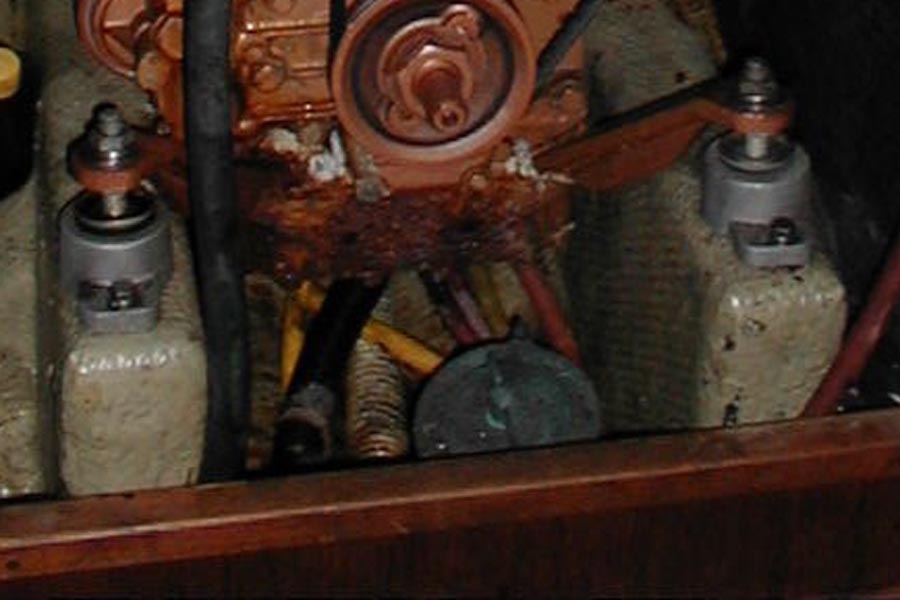Mariner 36's Construction
The hull is hand-laid 22-ounce woven roving combined with 1 1/2-ounce mat saturated with polyester resin. These layers are alternately laid down and patterned to yield excellent strength in all directions. There are more layers near the keel. The 5,650-lb foil shaped lead keel is bolted to the hull with 11 schedule 316 stainless, 3/4-inch diameter bolts. The seal between the keel and hull is achieved with gray butyl around all eleven-keel bolts. An aluminum-welded box is attached to two of the keel bolts and used as the step for the mast.
The deck is a non-skid glare reducing one piece molded fiberglass with resin impregnated end-grain balsa core combining strength with minimum weight. All deck gear and winch island pads are reinforced with resin saturated 1/2 inch mahogany plywood bonded into the deck mold. Winches, cleats and areas of stress due to equipment placement are backed with 1/4-inch aluminum plates. Gear is installed on the deck with a bed of butyl rubber gasket and the bolts are wrapped with gray butyl tape throughout.
The hull to deck joint is sealed with a Butyl rubber gasket and bolted with stainless 1/4 x 20 bolts on 4-inch centers. Every other bolt also secures the toe rail. Self-locking aircraft nuts are used throughout. Laminated pads are located underneath the Lifeline stanchions. These pads are bedded into the underside of the deck and then backed up with 1/4" aluminum pads. The pedestals are gasketed to the deck and sealed off at the bolts. There are ten Bowmar openings in the cabin top. The two large hatches on top of the deck have tinted lexan.
The rudder is cast in a split mold. It has a solid core with a molded fiberglass outer surface and a solid 2-inch stainless steel shaft with stainless steel support webs welded to the shaft. The top of the rudder shaft goes into a Delrin tube with a bronze stuffing box. The top bearing is mounted to a two-inch thick fiberglass encapsulated wood hanger. The Delrin tube is heavily laminated to the hull and extremely sturdy. Above the top bearing is the wheel for the cable. The wheel has a bolted on pipe section that is used as the mechanical stop to prevent turning the rudder up against the skeg. The stops are glass encapsulated wood blocks that are laminated to the bottom side of the cockpit floor.
The bottom of the rudder is attached to the skeg with a bronze skeg shoe using insulators for both the rudderpost and skeg bolt attachment. Some folks attach two small zincs to the bronze shoe to minimize corrosion to the 5/8-inch stainless mounting stud protruding from the skeg. The skeg is in turn bolted to three 5/8-inch studs protruding from the hull. The opening, in the skeg, for the attachment to the hull is then faired in by hand.
Engine beds are solid 2-inch mahogany timbers wrapped four ways with woven roving saturated with polyester resin and tabbed to the hull.
All bulkheads are tabbed for their full perimeter and kept 1/4 to 3/8-inch away from the hull. The bulkheads for the cabinetry are also tabbed in to the hull.
The chain plates are attached to knees made of plywood with glass over the wood and heavily tabbed into the hull under the deck. Large stainless steel bolts are used to attach the chain plates to the knees. The uppers are attached to the forward bulkhead main cabin. Where the chain plates go through the deck there is plywood as deck core and this plywood is very well sealed off at the openings for the chain plates. The opening for the chain plate is then grouted with 3M 5000 sealing compound at least once a year and a stainless cap is lowered around the chainplate to the grout to give the grout protection and press it into the opening one final time.
The two 12 volt batteries are located under the cockpit floor, directly in back of the engine, in a fiberglass box with a hold down cover that complies with Coast Guard Requirements. There are no batteries in the living area of the boat and the battery switch is a vapor proof type located in the galley.
There are seven encapsulated floor stringers perpendicular to the axis of the boat providing excellent structural strength under the cabin sole.
